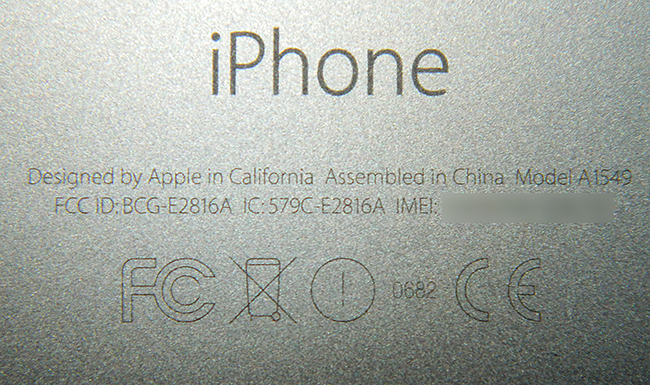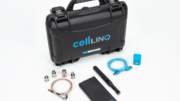So you’re stuck at the airport and your phone is dead. You’re so bored you turn the phone over to see what’s on the back of it. It’s not terribly interesting and depending on the light it may be pretty hard to read. (Believe me, it was pretty hard to take the photo above and have it be legible.)
That stuff is there because governments all over the world require them. There’ nothing there that really interests you and everything except the IMEI number (blurred out, because you know, that is a picture of my phone) and even that number isn’t really interesting on a daily basis. Every electronic device has to get approved by the governments of every country, and there has to be some sort of information saying so. There’s a new law in the United States saying that some of that information can be electronic instead of silk-screened, but it’s not expected to have a whole lot of impact since that stuff on the back applies to other countries as well and they haven’t passed a similar law. Let’s take a look at all that stuff and what it means.
First, the obvious “designed in California” which is not required by law but this is something Apple does to make you feel like this is an American product, even though it’s made in China and it clearly says so. The model number follows — you thought it was an iPhone 6 but it’s really an A1549. Those clever marketing people thought you’d like the “iPhone 6” name better.
The FCC ID is actually an identifier similar to a radio station’s call letters, and lets you know the device is registered with the FCC. The same is true with the IC number. IC stands for “Industry Canada” and it says that it’s ok to use the phone there as well. The IMEI (International Mobile Station Equipment Identity) number is a unique identifier that every GSM phone has (and anything with LTE will have as well.) It’s used to pair the phone with its SIM card and also can be used to stop the phone from working if it’s stolen.
Now let’s look at the logos below. Apple chose to make them as thin and hard to read as the law would allow and personally I don’t blame them. There are a lot of pictograms there and they’re not terribly helpful to the average person.
The first is the FCC logo. It says the equipment was approved by the FCC. Now maybe you’re thinking “duh” since it has an FCC ID, but it turns out that the law says it needs both the logo and the ID.
The next thing is an icon that’s supposed to look like a trash can with an X over it. This means the phone complies with the WEEE (Waste Electrical and Electronic Equipment) Directive, which is a European rule designed to discourage people from tossing things like phones into the trash. Here in the US we just call that common sense.
Then, you get an exclamation point in a circle, which is another European thing. It says the phone could, under certain circumstances, broadcast on frequencies that the government doesn’t approve of. For example, if you take your US phone to France then it’s not automatically going to stop using the US approved frequencies and start using the French ones. So, don’t take your phone to France. Instead, get a burner phone when you’re there. You’ll worry less anyway.
There’s a very small “0682” which tells anyone who cares that a third party called Cetecom ICT services did all the testing to make sure the thing conforms to even more European rules. Because, apparently there’s a real fear that you’re going to take your iPhone to the Czech Republic. I know I desperately dream of the day when I can send text messages from Zwittau, don’t you?
Finally, if the phone is in general compliance with every European regulation, it gets that CE logo. That doesn’t mean it will actually work in Europe, it just means that your phone won’t cause the downfall of our modern world and instantly fry all technology within a 500 mile radius just because you press the home button. I don’t know about you but I’m comforted by that.
So folks, there you have it. Other devices will have even more icons, and they generally apply to other countries that have certified the thing for use there. Some countries don’t terribly care if you use your technology there, and other countries just depend on the US or Europe to make sure everything works well.





